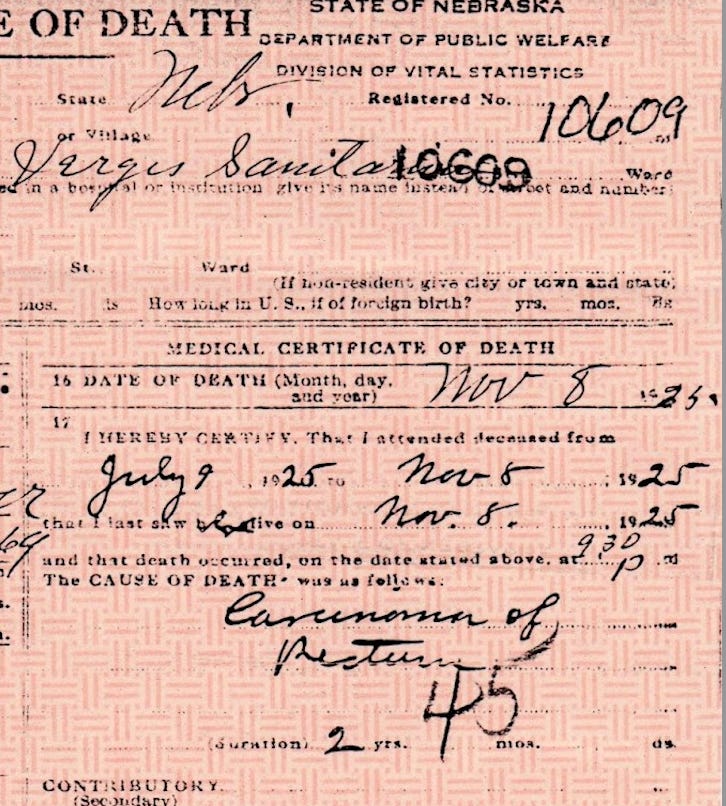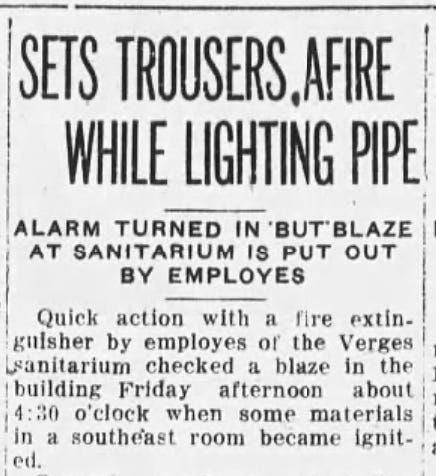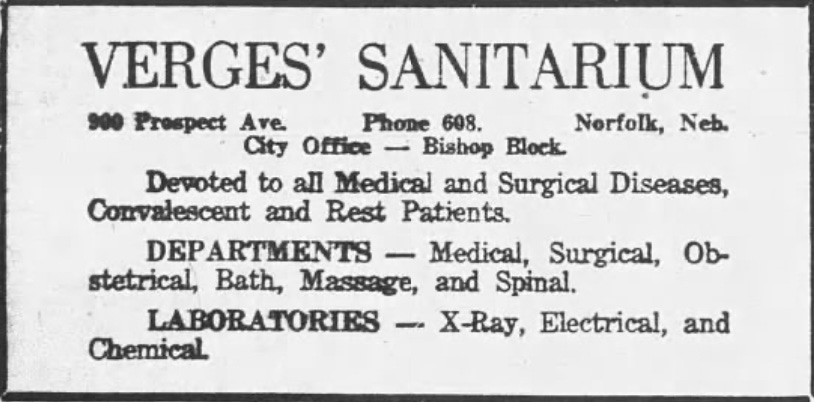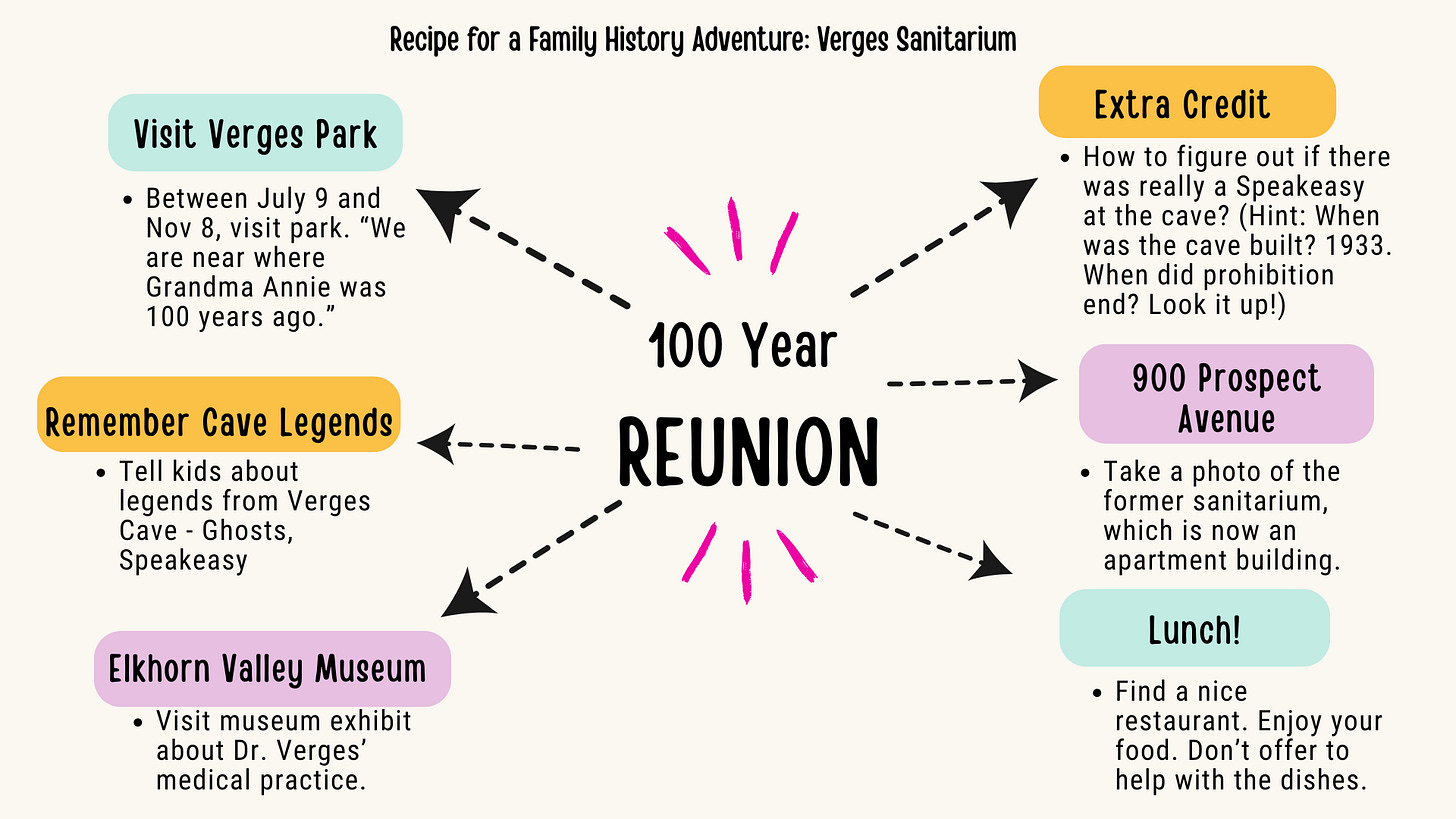A Reunion, a Sanitarium, and Some Very Flammable Pants
It started with a nurse’s goodbye and ended with a question for Grandma.
Reunions at the Genetics Center
I had my six month reunion last Thursday. At the genetics center. With my nurse practitioner. It's a nonprofit hospital, and every few days I get another email from another provider, “I am sorry to inform you that as of July 27 I will no longer be working at the hospital. It has been an honor to serve you …”
Nonprofit hospitals in my country of origin do not seem to be faring very well right now.
This last couple of weeks on SubStack Notes I’ve been talking about endings and beginnings. If you haven’t read Substack Notes, hop onto the website sometime and click on the “Notes” tab.
Here are a few recent notes that talked about endings and beginnings.
Grandma’s Legacy (Like it or Not)
When I went in for my genetic testing, all I knew was that Grandma Annie passed along a genetic mutation inherited from one of her parents.
I knew we had cousins coming down with cancer, left and right, year after year - some as young as 25, some as old as 75, some with multiple recurring cases, and some with a type of breast cancer called “triple-negative.” Whatever that was.
I was hopelessly uneducated for somebody who lost both grandmothers to cancer. But I can tell you now, triple-negative is not a positive thing. So after seeing the damage this mutation has already inflicted on my cousins, I thought, Wait! What if I have this, and I’ve passed it on to my descendants?
I called my doctor, who sent me to the genetics center. And sure enough, I do have the variant. Love you, Grandma. Thanks!
But so far, no cancer. The genetics center helped me understand next steps, which I followed. Now I go in every six months for follow-up exams, a semi-annual reunion with caring professionals who remember my name and history and always give me a hug.
These people keep a copy of the hand-drawn family tree created by my cousin. And they remember how relieved I was when we discovered that I had not passed this genetic distress along to my descendants.
There used to be two nurse practitioners, but one just sent out her “We regret” email. I feel a sense of foreboding. Are we looking at another ending?
A Hundred Years Ago
I’ve been wondering where Grandma Annie went for treatment back in 1925 when her cancer advanced to the point of no return. And how did she afford to pay for care?
If I pull out her death certificate, it shows that her cause of death was not breast cancer. It was “Carcinoma of Rectum.” My oncologist confirms that research is ongoing in the area of colorectal cancer risk for BRCA1. The risk seems higher for women under age 50, but generally when you think of BRCA1, you think more of breast, ovarian, and pancreatic cancers.
At any rate, she passed the genetic risk along to my dad, who had no idea. Since he lived 88 years cancer-free, I never thought I had any risk. That was … optimistic.
But I digress. I’m looking at this death certificate. Way up at the top on the right, it says where she was staying when she died, at a place called Verges Sanitarium.

It says she’s had this cancer for more than two years.
The doctor who signed the certificate states she was in his care from July 9 through November 8, 1925. I’m going to assume she was at Verges Sanitarium for these four months. That’s an educated guess based on the death certificate and family stories.
Let’s time travel back one hundred years. Here’s what that moment might have looked like.
It’s June. Grandma’s health is failing quickly. Grandpa Orlie is starting to look around, trying to figure out where he can take her for further care. Sometimes he works. Sometimes he wanders off and tells the family he’s looking for work.
The older boys are working, whenever they can find jobs.
17-year-old Sina keeps house and takes care of Grandma.
And 15-year-old Willie? That’s my dad. He just quit school to work in a restaurant washing dishes. Fun, fun!
It’s not that he’s against washing dishes. It’s the 12-hour days he doesn’t love. The pruny arms. The no days off. But he gets free meals. That’s a big deal. There isn’t much food at the Carver house.
So, back to my questions. What kind of place is this Verges Sanitarium. And since Grandma lives below the poverty line, how does she afford to stay here for four months?
The Sanitarium on Prospect Avenue
I ran a ChatGPT Deep Research report on Verges Sanitarium. Recently Denyse Allen and I talked about Deep Research Reports here. I like to use these as starting points for further research.
In the early 20th century, Norfolk, Nebraska was a growing plains city with few formal medical facilities. Dr. Carl J. Verges was a young doctor fresh out of med school. Doctoring ran in the family. His daddy was a doctor on the Nebraska frontier.
Verges was well-known in the community. He began his practice in 1908. In 1910 he bought a defunct brick factory and began turning it into a park. He named it Verges Park. In 1913 he was elected mayor, and later he served as city physician.
He started the sanitarium in 1918 at 900 Prospect Avenue, right next to Verges Park. By 1941 this was a 30-bed private hospital that served a cross-section of city residents, regardless of income level. It had an OB ward, surgery wards, and facilities for long term care.
I’m not sure when the hospital closed, but apparently the building may still be there, repurposed as an apartment building. So it’s possible that right now, today, I could send one of my cousins to take a picture of the building where Grandma stayed 100 years ago.
Maybe I could coax a whole group of cousins into a 100-year reunion. A family history adventure. Is that exciting, or just dumb? I think we could make it fun for kids.
Dr. Verges built a cave at Verges park. Verges Cave has sparked some fabulous legends. Is the cave haunted? Was there a little speakeasy hidden in there during prohibition? Hm …
In September, 1925, a construction accident at the hospital made big headlines. This would have been while Grandma was staying there. I wonder if she heard all the ruckus.

Henry Lindstead was helping to remodel a room at the hospital when he decided to light his pipe and caught his trousers on fire. Firetrucks came. A big crowd gathered. But the other workmen had already extinguished the flames by then. No smoking rules, apparently. But at least they did have a fire extinguisher.
Poor Henry. Another article in 1926 suggests he was later hospitalized due to a follow-up infection, so this must have been a serious burn.
The Paper Trail of Care
Henry’s moment got preserved in the local news, but Grandma’s story? If it’s in the paper, we’re going to have to dig a little more to find it. Which brings me to my other question. How could the family afford this care?
According to my Deep Research report, Nebraska law required counties to pay for care for their poor, although navigating the red tape often required legal action. It describes a case where Verges Sanitarium sued Morrill County for reimbursement of an unpaid patient bill. (Link below.)
When the county paid for something, it often showed up in old newspapers in a section titled something like, “Commissioners Proceedings.” Usually these are kind of cryptic, with names and dollar amounts. I’ve seen a few of these for Carvers and wondered what they covered, so let’s look more closely.
Here’s The Tilden Citizen Thu, Jan 28, 1926 ·Page 4. This is a couple of months after Grandma passed away. “C. J. Verges, care of Mrs. Carver … 120.85.”
On December 10 The Norfolk Press has another: “Dr. C. J. Verges, medical attention Mrs. Carver 156.50.”
And similar sums show up in The Tilden Citizen in late October, August, and July.
It looks like the cost of care was around $115 per month, plus whatever Grandpa was able to pay, if anything. Best guess, the hospital probably charged on a sliding scale.
I tried to find a link to a copyright-free photo of Dr. Verges, but as of now I don’t see one. However, I am looking at a Facebook page for the Elkhorn Valley Museum, and if you go there you can see a photo and comments from people who remember him as their doctor.
It sounds like this small hospital treated people well. I hope my grandmother was one of those who were treated well, and that her nurses were as kind as mine are now.
A Reunion of Another Kind
If I could go to Verges Park today, I might take a deep breath, close my eyes, and have my own mini-reunion with the woman whose DNA still gets me summoned to the genetics center every six months.
“Hi Grandma. We’re still here. We’re still surviving. We don’t know what new beginnings are coming next. I guess we’ll watch and see.
But while I’ve got you, just one question.
When Grandpa proposed… what made you say yes?”
Source Links
Colorectal Cancer Risk for BRCA1/BRCA2: https://pubmed.ncbi.nlm.nih.gov/25195694/
Who’s Who in Nebraska: https://usgennet.org/usa/ne/topic/resources/OLLibrary/who1940/co/madison3.htm#:~:text=Alpha%20Sigma%3B%20m%20Leota%20Daugherty,Prospect%3B%20res%20906%20Prospect%2C%20Norfolk
Dr. Verges Find-a-Grave Page: https://www.findagrave.com/memorial/231101684/carl_johannes_verges
Case where the Sanitarium Sued the County for an unpaid bill: https://govdocs.nebraska.gov/epubs/S3000/B001-1943.pdf
Elkhorn Valley Facebook Page: https://www.facebook.com/photo.php?fbid=946853662070108&id=237913339630814&set=a.316282358460578
More about Verges Park: https://usgenealogyresearch.atwebpages.com/nemcgs/newsletters_library/Vol.%2037%20No.%20181%20May-June%202016.pdf#:~:text=the%20brick%20yard%20property%20in,of%20the%20Park%20features%20still
And more from the museum: https://elkhornvalleymuseum.org/discover/verges-park/
Is the cave haunted?https://www.newschannelnebraska.com/story/47553145/is-verges-cave-haunted-halloween-time-sparks-curiosity-into-the-mysterious-cave
Madison County Genealogical Society Newsletters - a goldmine for genealogists in the area: https://usgenealogyresearch.atwebpages.com/nemcgs/newsletters_library/




